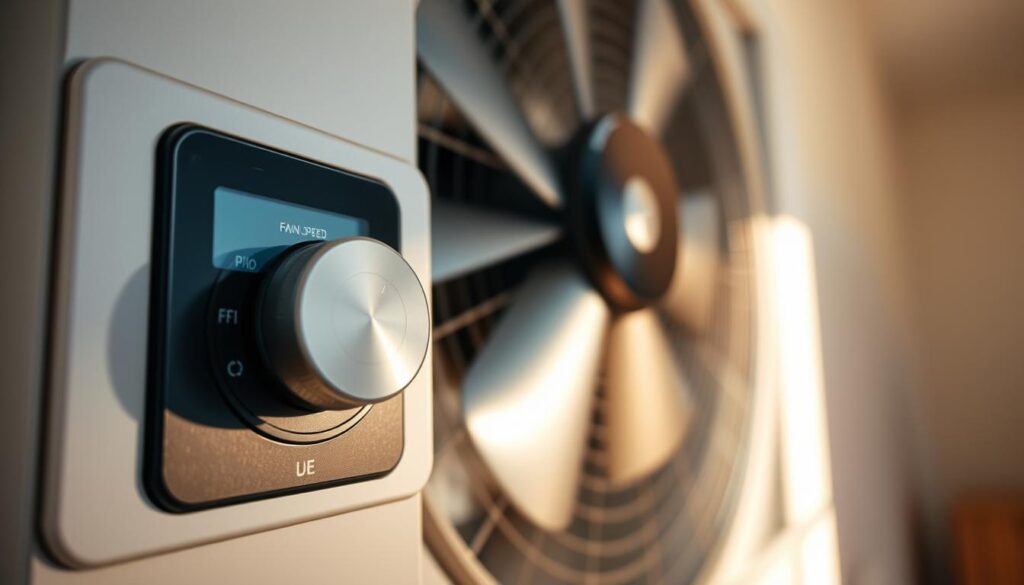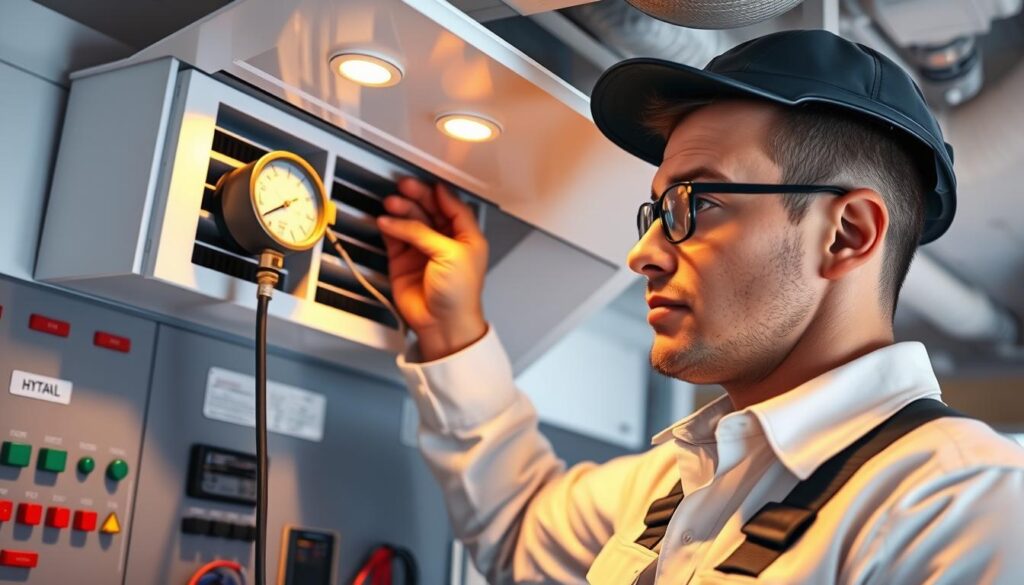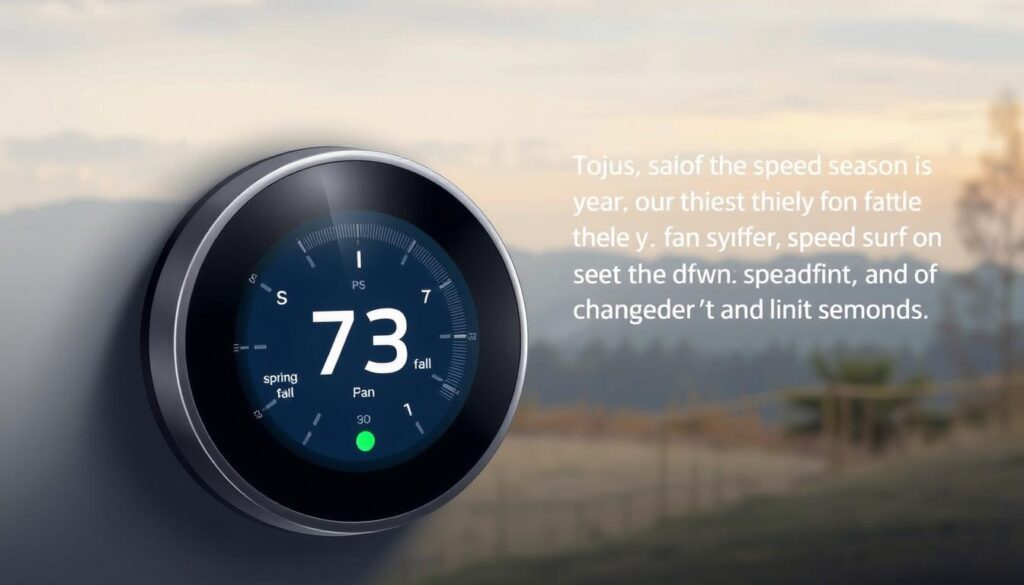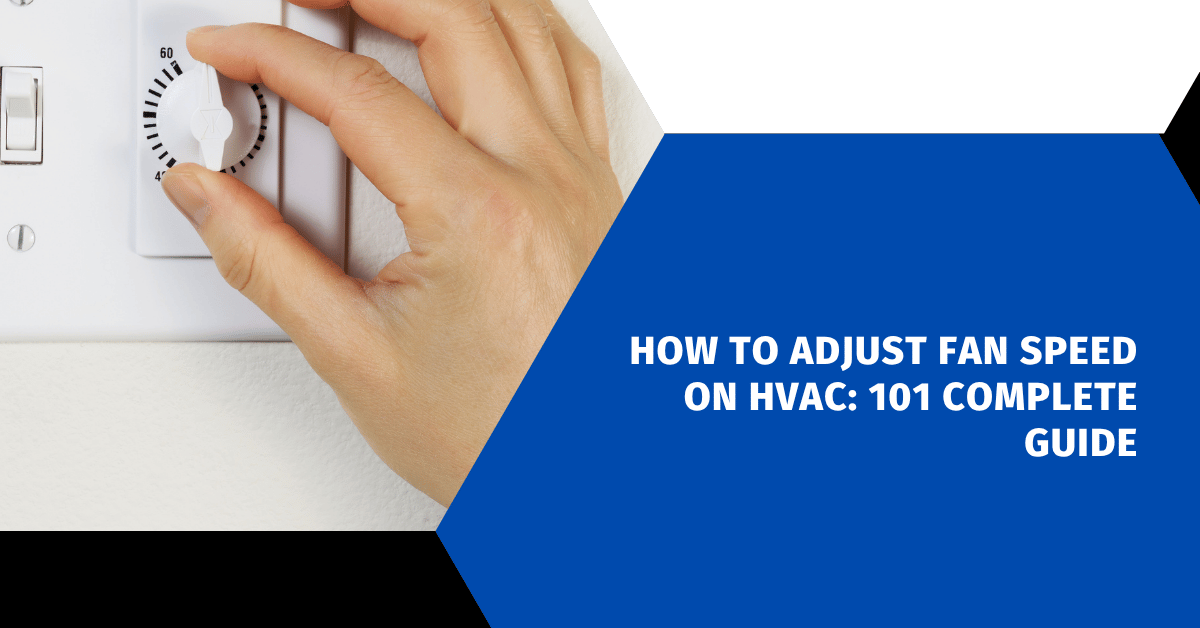Affiliate Disclosure
HVAC Guide Guys is a participant in the Amazon Services LLC Associates Program, an affiliate advertising program designed to provide a means for sites to earn advertising fees by advertising and linking to Amazon.
How to Adjust Fan Speed on HVAC? Are you tired of uneven temperatures and high energy bills? Adjusting your HVAC fan speed could change your home’s comfort and save energy.

Learning to adjust fan speed on HVAC is crucial. It helps create a balanced indoor environment. Your heating and cooling system needs precise fan speed control for best performance.
HVAC fan speed control is more than comfort. It boosts system efficiency, cuts energy use, and keeps temperatures even. Whether it’s summer or winter, adjusting your system can make a big difference.
Key Takeaways
- Fan speed adjustment impacts overall HVAC system performance
- Proper control can reduce energy consumption
- Different fan speeds suit various seasonal needs
- Professional guidance can prevent potential system damage
- Regular maintenance supports optimal HVAC functionality
Table of Contents
Understanding HVAC Blower Systems
Your home’s HVAC system has a key part that makes sure air moves well in every room. The blower system is at the heart of your heating and cooling. It controls air flow with great precision and efficiency.
The blower system is at the center of your climate control. It works hard to spread air evenly in your home. Knowing how it works can help make your home more comfortable and save energy.
Key Components of a Blower System
- Blower Motor: The main mover of air
- Fan Wheel: Pushes air through ducts
- Housing: Keeps the parts safe and together
- Electrical Controls: Control fan speed
How Blower Motors Function
Blower motors turn electrical energy into motion. They make the fan wheel spin at different speeds. This creates air flow that spreads heated or cooled air around your home. Being able to change fan speed helps you save energy and feel more comfortable.
| Speed Mode | Airflow Characteristics | Energy Efficiency |
|---|---|---|
| Low Speed | Gentle, consistent circulation | High efficiency |
| Medium Speed | Balanced air distribution | Moderate efficiency |
| High Speed | Rapid air movement | Lower efficiency |
Impact on Home Comfort
The blower system greatly affects your home’s comfort. Good air circulation keeps temperatures steady, controls humidity, and improves air quality. By knowing and improving your HVAC’s blower system, you can make your home more comfortable and save energy.
Types of HVAC Fan Motors
Knowing the different HVAC fan motors is key to adjusting the blower motor speed. Your home’s comfort depends on picking the right motor for your heating and cooling needs.
HVAC systems usually have three main motor types:
- Single-Speed Motors: The simplest option that runs at one fixed speed
- Multi-Speed Motors: Offer two or three speed settings
- Variable-Speed Motors: Provide the most flexible and efficient airflow control
Single-speed motors are the traditional choice. They work at full speed all the time. This can use more energy and make temperature control less precise.
Multi-speed motors give you more control. They switch between set speeds to save energy and improve comfort. You can adjust airflow for different rooms or with the seasons.
“The right motor type can significantly improve your HVAC system’s performance and energy efficiency.” – HVAC Engineering Experts
Variable-speed motors are the latest technology for adjusting blower motor speed. They can change airflow rates continuously. This gives you better temperature control and cuts down energy costs.
Explore Our HVAC Shop
Looking for top-rated HVAC tools, parts, and accessories? Visit our shop and find the perfect solution for your needs.
Visit the ShopBenefits of Proper Fan Speed Adjustment
Adjusting your HVAC thermostat fan settings can make your home more comfortable and efficient. It’s not just about controlling the temperature.
Boosting your HVAC fan power has many benefits for homeowners. The correct fan speed can greatly enhance your home’s performance and comfort.
Energy Efficiency Improvements
Adjusting your fan speed right can cut down on energy use. You can:
- Use less electricity
- Save on your monthly bills
- Reduce strain on your system
Enhanced Temperature Control
Controlling fan speed precisely helps keep temperatures even. Your home will stay at a consistent temperature with the right airflow.
Better Air Quality Management
Optimal fan settings also improve air circulation indoors. This leads to:
- Better air filtration
- Less dust and allergens
- Improved air quality
Mastering your HVAC thermostat fan settings is key to creating a comfortable, efficient home environment.
How to Adjust Fan Speed on HVAC
Controlling HVAC airflow needs careful attention and expertise. Some homeowners might try to adjust fan speed themselves. But, getting professional help is key to keeping your system running well.
To adjust fan speed on HVAC systems, follow these steps:
- Identify your specific HVAC model’s requirements
- Check the manufacturer’s manual for precise instructions
- Understand the potential risks of improper adjustments
- Recognize when professional intervention is necessary
Professional HVAC technicians use special tools to adjust fan speed. They can:
- Locate the blower motor’s control panel
- Measure current airflow rates
- Calibrate speed settings accurately
- Test system performance after adjustments
Safety should always be your primary concern when dealing with HVAC systems. Wrong fan speed adjustments can cause problems. These include lower efficiency, more energy use, and damage to the system.
Remember: Precision in HVAC fan speed control directly impacts your home’s comfort and energy efficiency.
Homeowners should get a professional assessment for fan speed management. A skilled technician can do a full check and suggest the best adjustments for your HVAC system.
Explore Our HVAC Shop
Looking for top-rated HVAC tools, parts, and accessories? Visit our shop and find the perfect solution for your needs.
Visit the ShopSafety Precautions Before Adjustments
Working with HVAC systems needs careful safety attention. Before you start any hvac fan speed troubleshooting, you must take important precautions. Electrical systems can be dangerous if not handled right.
Always put safety first when adjusting your HVAC system. Experts suggest following certain steps for a safe and effective process.
Power Disconnection Steps
Turning off power is the most important safety step for hvac fan speed troubleshooting. Here are the key steps:
- Find your home’s main electrical panel
- Find the circuit breaker for your HVAC system
- Switch the breaker to the OFF position
- Use a voltage tester to check for no electrical current
Required Tools and Equipment
Having the right tools is key for safe HVAC maintenance. Get these items before starting your fan speed troubleshooting:
- Insulated electrical gloves
- Voltage tester
- Screwdriver set
- Multimeter
- Flashlight
System Compatibility Check
Not all HVAC systems are the same. Before making any changes, check if your system is compatible. Look at your manufacturer’s manual or talk to a professional. This ensures you can safely change the fan speed without damage.
Remember: When in doubt, always contact a certified HVAC technician for professional assistance.
Professional vs DIY Fan Speed Adjustment

Homeowners often wonder if they should get help from pros or try to adjust fan speeds themselves. Your HVAC system works best when fan speeds are just right. This needs special knowledge and tools.
Professional HVAC techs have the skills to fine-tune fan speeds. They know how to balance air for the best system performance. They use special tools to measure and adjust air flow accurately, something most homeowners can’t do.
- Comprehensive system diagnostics
- Precise air flow measurements
- Advanced calibration techniques
- Detailed performance assessments
Trying to adjust fan speeds yourself can be risky. Wrong adjustments can:
- Make your system less efficient
- Use more energy
- Damage your equipment
- Void your warranty
| Professional Service | DIY Adjustment |
|---|---|
| Guaranteed precision | Potential inaccuracy |
| Comprehensive system analysis | Limited diagnostic capabilities |
| Long-term cost savings | Risk of expensive repairs |
Getting professional help for hvac system air balancing can save you money and make your system last longer. While you can handle simple tasks, complex fan speed adjustments need an expert’s touch for the best results.
Explore Our HVAC Shop
Looking for top-rated HVAC tools, parts, and accessories? Visit our shop and find the perfect solution for your needs.
Visit the ShopCommon Fan Speed Issues and Solutions
Fixing HVAC fan speed problems can be tough for homeowners. Knowing common issues and fixes helps keep your system running well. It also avoids expensive repairs.
Your HVAC system works best when fan speeds are right. Spotting problems early can prevent big damage and unexpected breakdowns.
Troubleshooting Guide
Here are key steps for hvac fan speed troubleshooting:
- Check air filter condition and replace if dirty
- Inspect thermostat settings and calibration
- Listen for unusual noises during operation
- Measure airflow from different vents
Performance Indicators
Signs of fan speed problems include:
- Inconsistent room temperatures
- Weak airflow from vents
- Increased energy consumption
- Strange sounds during system operation
When to Call a Professional
Some hvac fan speed issues need a pro. Call a technician if you notice:
- Persistent loud grinding or squealing noises
- Complete system fan failure
- Electrical issues or motor malfunction
- Repeated circuit breaker tripping
While you can try basic fixes, complex repairs are best left to certified techs. They ensure safety and avoid more damage.
Seasonal Considerations for Fan Speed

Your HVAC thermostat fan settings are key to keeping your home comfy all year. Each season needs a special way to manage fan speed for the best temperature and air quality.
In winter, using lower fan speeds helps spread warm air evenly. This stops cold spots and cuts down on energy use. Smart HVAC systems let you fine-tune fan settings for better performance.
- Summer: Higher fan speeds improve air circulation and humidity control
- Winter: Lower fan speeds provide gentle, consistent heat distribution
- Spring/Fall: Moderate fan speeds balance comfort and energy efficiency
Humidity levels also affect the best fan settings. In humid summers, turn up the fan to remove moisture. In dry winter air, use gentle fan speeds to avoid losing more moisture.
| Season | Recommended Fan Speed | Primary Goal |
|---|---|---|
| Summer | High | Cooling and Dehumidification |
| Winter | Low | Efficient Heating Distribution |
| Spring/Fall | Medium | Balanced Comfort |
Modern smart thermostats can change fan speeds automatically with the seasons. This smart move keeps your home comfy all year. By knowing and using these seasonal tips, you can get the most out of your HVAC system and keep your home cozy.
Explore Our HVAC Shop
Looking for top-rated HVAC tools, parts, and accessories? Visit our shop and find the perfect solution for your needs.
Visit the ShopAdvanced Fan Speed Control Technologies
Modern HVAC systems are changing how we feel at home with new fan speed control tech. These innovations go beyond old single-speed motors. They bring a new level of precision to keeping your home just right.
Variable-speed motors are a big step forward in fan speed control. They let your system adjust airflow as needed. This means your home gets the perfect heating and cooling, using less energy.
- Smart thermostat integration enables real-time fan speed adjustments
- Zone-based control systems provide targeted temperature management
- Advanced sensors monitor indoor air quality and comfort levels
New HVAC tech uses smart algorithms that learn your home’s heat patterns. These systems can predict and adjust fan speeds before you even ask. This makes your home more comfy and saves energy.
Getting these advanced fan speed control systems can save you money in the long run. You’ll see:
- Lower energy bills
- Even temperatures inside
- Better air flow
- A longer life for your HVAC system
As tech keeps getting better, these advanced fan speed systems are the future of home climate control. They promise unmatched comfort and efficiency.
Conclusion
Learning to adjust your HVAC fan speed is key for comfort and saving energy. It helps your system work better and cuts down on energy waste.
Controlling your HVAC fan speed does more than just control temperature. It affects your home’s air quality, energy costs, and comfort. Knowing how to adjust fan speed lets you make better choices for your home.
Keeping your HVAC system in check is important. Regular checks and adjustments can stop problems and make your system last longer. Some tweaks you can do yourself, but for complex systems, it’s best to get help from experts.
Your home’s comfort needs change with the seasons and how you use it. Stay on top of your HVAC system’s performance. Learn about fan speed control to make your home more comfortable and efficient for years.

